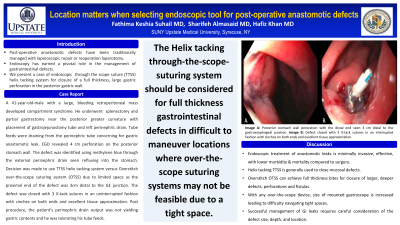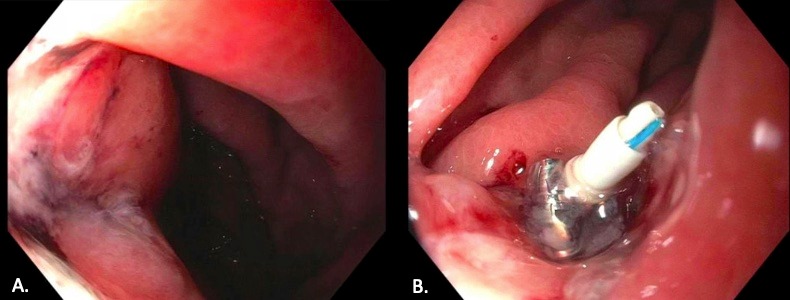Sunday Poster Session
Category: Interventional Endoscopy
P0865 - Choose Wisely – Location Matters When Selecting Appropriate Endoscopic Tool for Post-Operative Anastomotic Defects
Sunday, October 22, 2023
3:30 PM - 7:00 PM PT
Location: Exhibit Hall

Has Audio
- FS
Fathima Suhail, MD
SUNY Upstate Medical University
Syracuse, NY
Presenting Author(s)
Award: Presidential Poster Award
Fathima Keshia Suhail, MD, Hafiz M. Khan, MD
SUNY Upstate Medical University, Syracuse, NY
Introduction: Gastrointestinal (GI) leaks are feared complications mostly related to post-operative anastomotic defects. There are various management options including laparoscopic repair or reoperation by laparotomy. Endoscopy has earned a pivotal role in the management of GI defects. We present a case of the use of X-tack (Apollo Endosurgery, Austin, Tex, USA) through the scope suture (TTSS) for closure of a full thickness, large gastric perforation in the posterior gastric wall.
Case Description/Methods: A 41-year-old male presented with hemorrhagic shock and found to have a large retroperitoneal mass requiring embolization of the left gonadal artery. He developed compartment syndrome requiring laparotomy revealing a mass occupying majority of the abdomen. He underwent a left colectomy, splenectomy, and partial gastrectomy near the posterior greater curvature and placement of gastrojejunostomy tube and left perinephric drain. Tube feeds was draining from perinephric tube concerning for gastric anastomotic leak. Upper endoscopy revealed perforation on the posterior wall of the stomach. The 4cm defect identified pushing methylene blue through the external drain refluxing into the stomach. Decision made to use X-tack sutures. Overstitch was considered but there was limited space as the proximal end of the defect was 3cm distal to the GE junction. The defect was closed with three 3-0 polypropylene X-tack sutures in an interrupted fashion with cinches on both ends and excellent tissue approximation. Post procedure, the patient’s perinephric drain output was not yielding gastric contents and he was tolerating his tube feeds,
Discussion: Endoscopic treatment of anastomotic leaks is minimally invasive, effective, with lower morbidity and mortality compared to surgery. Endoscopic closure devices have broadened the indications of endoscopy for management of GI wall defects. X-tack TTSS is generally used to close mucosal defects. In contrast, Overstitch over-the-scope suturing (OTSS) can achieve full thickness bites for closure of larger, deeper defects, perforations, and fistulas. With any over-the-scope device, the size of the device-mounted gastroscope is increased, which can lead to difficulty in reaching tight spaces. Successful management of GI leaks requires careful consideration of defect size, depth, and location. Our case demonstrates the accessibility of X-tack TTSS for successful closure of a full thickness defect in a difficult to maneuver location where OTSS may not be feasible due to a tight space.

Disclosures:
Fathima Keshia Suhail, MD, Hafiz M. Khan, MD. P0865 - Choose Wisely – Location Matters When Selecting Appropriate Endoscopic Tool for Post-Operative Anastomotic Defects, ACG 2023 Annual Scientific Meeting Abstracts. Vancouver, BC, Canada: American College of Gastroenterology.
Fathima Keshia Suhail, MD, Hafiz M. Khan, MD
SUNY Upstate Medical University, Syracuse, NY
Introduction: Gastrointestinal (GI) leaks are feared complications mostly related to post-operative anastomotic defects. There are various management options including laparoscopic repair or reoperation by laparotomy. Endoscopy has earned a pivotal role in the management of GI defects. We present a case of the use of X-tack (Apollo Endosurgery, Austin, Tex, USA) through the scope suture (TTSS) for closure of a full thickness, large gastric perforation in the posterior gastric wall.
Case Description/Methods: A 41-year-old male presented with hemorrhagic shock and found to have a large retroperitoneal mass requiring embolization of the left gonadal artery. He developed compartment syndrome requiring laparotomy revealing a mass occupying majority of the abdomen. He underwent a left colectomy, splenectomy, and partial gastrectomy near the posterior greater curvature and placement of gastrojejunostomy tube and left perinephric drain. Tube feeds was draining from perinephric tube concerning for gastric anastomotic leak. Upper endoscopy revealed perforation on the posterior wall of the stomach. The 4cm defect identified pushing methylene blue through the external drain refluxing into the stomach. Decision made to use X-tack sutures. Overstitch was considered but there was limited space as the proximal end of the defect was 3cm distal to the GE junction. The defect was closed with three 3-0 polypropylene X-tack sutures in an interrupted fashion with cinches on both ends and excellent tissue approximation. Post procedure, the patient’s perinephric drain output was not yielding gastric contents and he was tolerating his tube feeds,
Discussion: Endoscopic treatment of anastomotic leaks is minimally invasive, effective, with lower morbidity and mortality compared to surgery. Endoscopic closure devices have broadened the indications of endoscopy for management of GI wall defects. X-tack TTSS is generally used to close mucosal defects. In contrast, Overstitch over-the-scope suturing (OTSS) can achieve full thickness bites for closure of larger, deeper defects, perforations, and fistulas. With any over-the-scope device, the size of the device-mounted gastroscope is increased, which can lead to difficulty in reaching tight spaces. Successful management of GI leaks requires careful consideration of defect size, depth, and location. Our case demonstrates the accessibility of X-tack TTSS for successful closure of a full thickness defect in a difficult to maneuver location where OTSS may not be feasible due to a tight space.

Figure: Figure 1: Closure of gastric anastomotic leak in the posterior gastric wall with X-tack through the scope suturing device.
Disclosures:
Fathima Keshia Suhail indicated no relevant financial relationships.
Hafiz Khan indicated no relevant financial relationships.
Fathima Keshia Suhail, MD, Hafiz M. Khan, MD. P0865 - Choose Wisely – Location Matters When Selecting Appropriate Endoscopic Tool for Post-Operative Anastomotic Defects, ACG 2023 Annual Scientific Meeting Abstracts. Vancouver, BC, Canada: American College of Gastroenterology.

